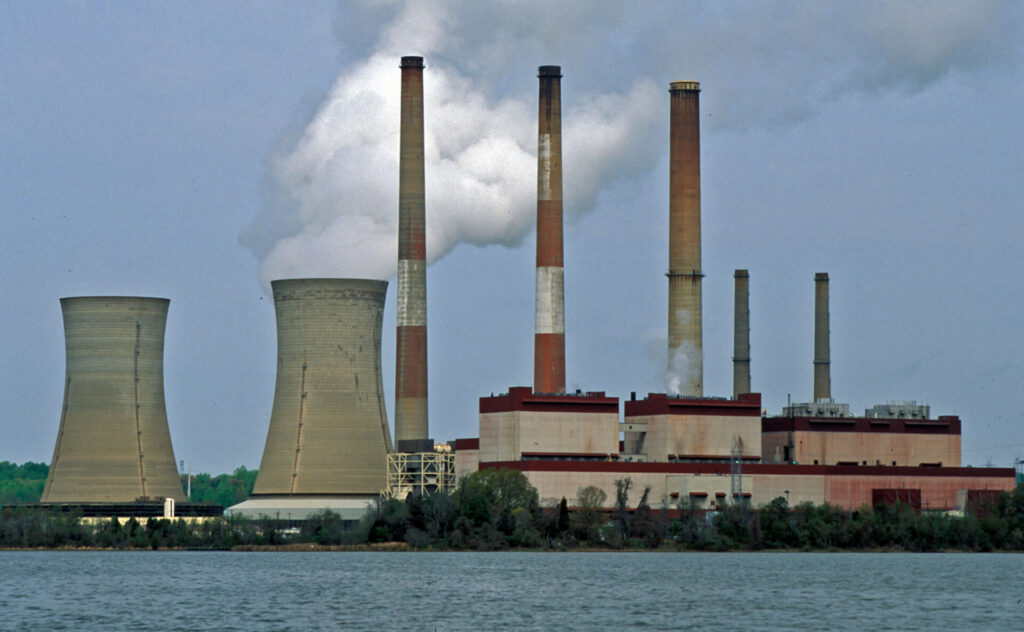
The coal-fired Chalk Point power plant in Prince George’s County was recently closed. Maryland is part of a regional program to limit emissions from power plants. Photo courtesy of the Integration and Application Network, University of Maryland Center for Environmental Science.
Here’s some rare good news for Marylanders on climate change: A new analysis of federal government data found that Maryland led the way when it came to states reducing greenhouse gas emissions over a 17-year period.
Maryland cut carbon emissions by 36% between 2005 and 2022 and by 42% per capita, according to the report released this week by Environment America Research & Policy Center.
The center, part of Environment America, a national network of 30 state environmental groups that includes Maryland PIRG, took data from the U.S. Environmental Protection Agency on greenhouse gas emissions across the nation and used the numbers to evaluate the states’ performance reducing carbon pollution.
While Maryland saw emissions reductions in most sectors, the building sector continues to lag — a fact reinforced by another environmental study that was released this week.
Nationally, the United States reduced its overall greenhouse gas emissions by 15% and its per capita emissions by 25% — though the report found significant variations in emissions trends by state for the 2005-2022 period. Maryland was the top state in reducing emissions of planet-warming greenhouse gases, followed by the District of Columbia, Maine, New Hampshire and Georgia.
While 44 states reduced their carbon emissions over the 17 years, Mississippi, Texas, Nebraska, South Dakota, Idaho and North Dakota saw increases, largely attributable to increased oil and gas production in those states. Every state but North Dakota decreased their emissions on a per capita basis.
Ferguson seeks to remove incinerators from state’s renewable energy subsidy program
Emily Scarr, senior adviser with the Maryland Public Interest Research Group (PIRG) Foundation, attributed the state’s strong showing to durable state policies and its participation in the Regional Greenhouse Gas Initiative (RGGI), a consortium of Northeastern and mid-Atlantic states that have worked together to cut coal plant emissions. Collectively, the initial 10 RGGI states (excluding Pennsylvania) cut pollution from power plants by 50% from 2005 to 2023, with much of that reduction resulting from the closure of coal-fired power plants.
“Our progress in reducing greenhouse gas emissions shows that state and regional policies and actions can make a difference,” Scarr said. “Improving the efficiency of our homes, retiring coal plants, and making cars that pollute less all contributed to the decline we’ve seen.”
According to the analysis, Maryland has reduced its emissions in the electric power sector, industrial sector, agricultural sector, transportation sector and residential sector. The largest decrease was in the electric power sector, cutting emissions by 66% between 2005 and 2022. Maryland has seen several coal plants shuttered while others are scheduled to do so; states that still produce a significant amount of their electricity using coal and gas saw fewer reductions and have high per capita emissions.
As of 2022, Maryland saw only a 4% reduction in emissions from the residential sector, however, leaving significant room for improvement. And the only sector that has seen an increase in emissions in Maryland is the commercial buildings sector, which saw a 23% rise in emissions. In 2022, the majority of carbon emissions from the commercial sector was from burning fossil fuels for heat and hot water in commercial buildings.
The latter finding was echoed in a newly released study commissioned by the Sierra Club, which found that buildings play an unexpectedly large role in contributing to dangerous levels of smog pollution.
Smog pollution, otherwise known as ground-level ozone, is a major public health issue in Maryland, with approximately 5.1 million Marylanders living in areas with unsafe levels of smog. Smog can cause chronic respiratory illnesses, asthma attacks, bronchitis, and premature death, and it’s a particular problem in the state’s more urban areas.
While heavy-duty vehicles and power plants contribute to smog, the Sierra Club study, conducted by Sonoma Technology, found that gas-burning appliances in buildings, like water heaters, play an increasing part in contributing to smog pollution.
Maryland is in the process of implementing Building Energy Performance Standards (BEPS) as required under the Climate Solutions Now Act of 2022. The standards apply to large buildings in the state, including commercial buildings, with a goal of achieving zero net direct greenhouse gas emissions by 2040.
YOU MAKE OUR WORK POSSIBLE.
But the Sierra Club and other environmental groups have argued that Maryland can reduce its smog problem by requiring buildings to replace dirty gas-burning equipment with clean, efficient electric equipment, such as efficient heat pumps.
“Maryland can take action to reduce pollution from the building sector by adopting policies that promote clean, energy-efficient electric equipment in buildings,” said Josh Tulkin, director of the Sierra Club Maryland Chapter. “Such policies would significantly improve public health and help Maryland meet its climate goals.”
The release of the two studies comes as Maryland scrambles to meet its goal of reducing greenhouse gas emissions by 60% by 2031 and having a carbon-neutral economy by 2040. The state’s plans to implement ambitious climate programs and promote the use of clean energy could be stymied by their high price tag: A study released late last year by the Maryland Department of the Environment (MDE) estimated that it would cost the state about $10 billion to achieve all its climate goals — at a time when the state’s revenue estimates are gloomy.
World leaders are meeting this week and next in Azerbaijan for the annual United Nations climate conference, amid fears that President-elect Donald Trump will pull the U.S. from its previous international climate commitments and try to dismantle many of President Joe Biden’s climate and clean-energy initiatives. MDE Secretary Serena McIlwain is attending the conference, as she did last year.

